
e-mail :  ( Please write in ' Subject ' entry : ' METAPHYSICS ', in order for me to be able to distinguish your mail from spam )
( Please write in ' Subject ' entry : ' METAPHYSICS ', in order for me to be able to distinguish your mail from spam )
Evolution of Insects in terms of the Implicate and Explicate Orders.
Part IIIbb
Noëtic construction of the various palaeozoic blattarian tegmina.
Having, in the previous document, presented the most diverse palaeozoic Blattida fauna (Wettiner basin), it is, before we continue with the other two Blattida faunae (Dunkard and Kuznets), interesting and instructive to present an attempt to say something more about the probable noëtic construction, in the Implicate Order, of the various types of tegmina in palaeozoic Blattida. When this has been done, the reader may then in a better position to interpret not only the Blattida of the Saar and Wettiner faunae, but also those of the other two faunae.
In order to fully appreciate the exposition of the noëtic construction of blattida tegmina with the help of so-called polydiagrams, the reader may consult the two-document " Theoretic Intermezzo" which is inserted into the present series of documents after part VIII (Heteropterygia). For "polydiagrams" in particular the reader should, in that same " Theoretic Intermezzo", consult the Section Polyphyletic development of strategy-contents and their noëtic construction in the Implicate Order (to be found at about the last sixth of the (first) document).
The palaeozoic blattarian tegmina may be divided into five morphological subtypes, viz., the Archaic archimylacrid subtype, the Phyloblatta subtype, the Spiloblattinid subtype, the Poroblattinid subtype, and the Mylacrid subtype.
Let us give some typical representatives of each of these subtypes.
Archaic archimylacrid subtype :

|
Archimylacris lerichei PRUVOST.
Family Archimylacridae.
Length of tegmen 32.5 mm.
Upper Carboniferous of France.
(After PRUVOST, 1919, in TILLYARD, 1937)
|
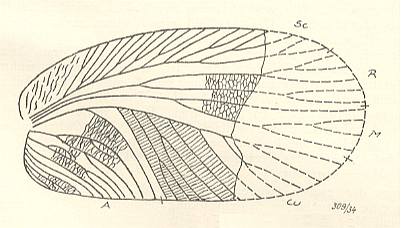
|
Archimylacris diensti GUTHÖRL.
Family Archimylacridae.
Presumed length of whole tegmen 21 mm.
Location : Deep-drilling Velsen II at the mine (Grube) Velsen-Saar. Depth 1360 m.
Stratum : Westphalian C, lower Saarbrücker Schichten [layers], Fettkohlenpartie, Sulzbachflöz group.
After GUTHÖRL, 1934, abb.67, p. 113.
|
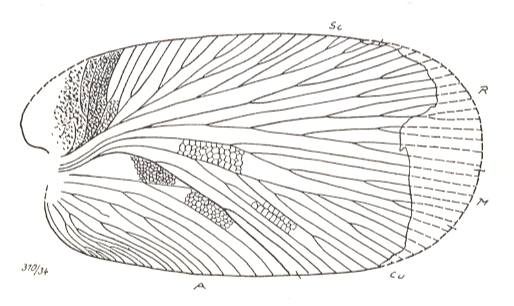
|
Platyblatta steinbachensis KLIVER.
Family Archimylacridae.
Length of complete wing about 36 mm.
Location : Mine (Grube) of the Heydt-Saar. Spoil tip (Halde) in Steinbachtal.
Stratum : Westphalian D, upper Saarbrücker Schichten, Liegende [= lower part of] Flammkohlenpartie,
2. Liegende Flöz.
After GUTHÖRL, 1934, p.115, Abb. 68.
|
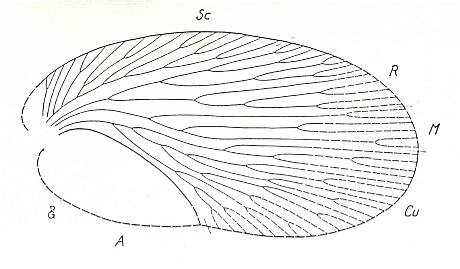
|
Guichenbachia gigantea GUTHÖRL.
Family Archimylacridae.
Length of whole wing about 50 mm.
Location : Mine (Grube) Guichenbach near Heusweiler-Saar.
Stratum : Stephanian A, lower Ottweiler Group, Dilsburger Schichten, roof of Flöz Wahlschied.
After GUTHÖRL, 1963, p.249, Abb. 2.
|
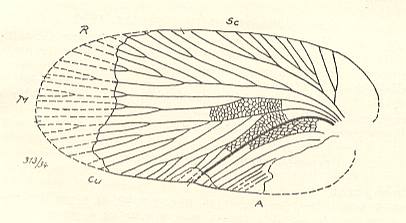
|
Etoblattina primaeva GOLDENBERG. Family Archimylacridae. Order Blattaria. Tegmen. Length of preserved part 27.0 mm. Total length about 33.0 mm.
Middle Upper-Carboniferous of Saar Region, Germany.
(After GUTHÖRL, 1934).
|
As can be seen, the Archaic archimylacrid (tegminal) type indeed is characterized by a relatively broad tegmen, and a relatively wide subcostal area with more or less radiating or dichotomically split branches of Sc in it.
Phyloblatta subtype :
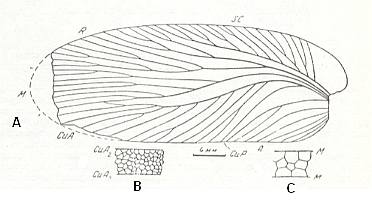
|
Phyloblatta carbonica BECKER-MIGDISOVA.
Family Archimylacridae.
Length of tegmen about 36.5 mm.
A - tegmen (forewing). B, C - archedictyon.
Carboniferous of Zjelty Jar, basin of Kuznetsk, Siberia, Russia.
(After ROHDENDORF et al., 1961)
|

|
Phyloblatta martynovi BECKER-MIGDISOVA.
Family Archimylacridae.
Probable length of (whole) tegmen about 26 mm.
Tegmen and Archedictyon.
Carboniferous of Zjelty Jar, basin of Kuznetsk, Siberia, Russia.
(After ROHDENDORF et al., 1961)
|
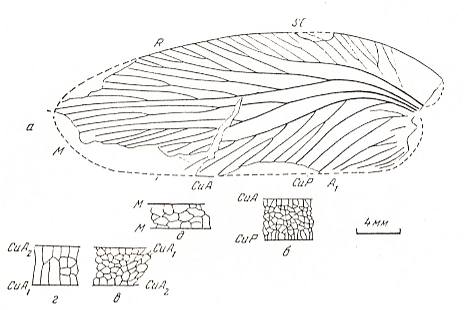
|
Phyloblatta distincta MARTYNOV.
Family Archimylacridae.
Length of (whole) tegmen 26-34 mm. (several specimen)
Tegmen and Archedictyon.
Carboniferous of Zjelty Jar, basin of Kuznetsk, Siberia, Russia.
(After ROHDENDORF et al., 1961)
|
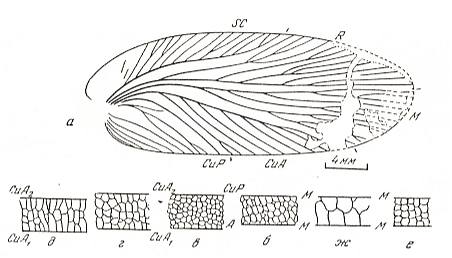
|
Phyloblatta alykaevensis BECKER-MIGDISOVA.
Family Archimylacridae.
Length of (whole) tegmen 32 mm.
Tegmen and Archedictyon.
Carboniferous of Zjelty Jar, basin of Kuznetsk, Siberia, Russia.
(After ROHDENDORF et al., 1961)
|
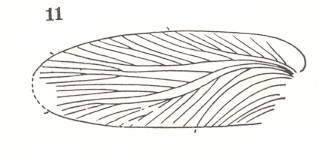
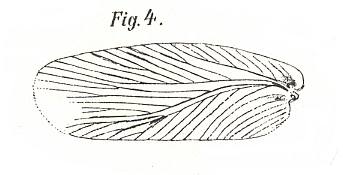
|
Phyloblatta flabellata GERMAR
Family Archimylacridae.
Length of tegmen about 18 mm.
Locality : Wettin in Sachsen.
Stratum : Ottweiler Stufe, upper Upper-Carboniferous.
(Upper image after HANDLIRSCH, 1906, Taf.XXII, fig.11, description p.211)
(Lower image after SCHLECHTENDAL, 1912, Tab.V, fig.4)
Both images are of the same specimen.
|

|
Phyloblatta plana SCHLECHTENDAL
Family Archimylacridae.
Length of tegmen about 26 mm.
Locality : Wettin in Sachsen.
Stratum : Ottweiler Stufe,
upper Upper-Carboniferous.
(After HANDLIRSCH, 1906, Taf.XXII, fig.16, description p.213)
|

|
Phyloblatta gracilis GOLDENBERG
Family Archimylacridae.
Length of tegmen, 18 mm.
Location : Lebach-Saar. Toneisensteingruben (GUTHÖRL, 1934). SCHLECHTENDAL, 1912, p.149 indicates : Lebach, in the Toneisenstein of the lower Rotliegendes.
Stratum : (GUTHÖRL, 1934) lower Rotliegendes, Lebacher Schichten, Toneisensteinlager.
Upper image : after HANDLIRSCH, 1906, Taf. XXXV, fig. 8, and p.353.
Middle image : after SCHLECHTENDAL, 1912, Tab. X, fig. 10. (see also ibidem, p.148).
Bottom image : after GUTHÖRL, 1934, p.124, Abb. 73.
All three images refer to the same specimen [JB].
|
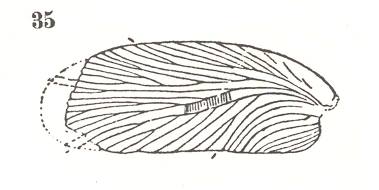
|
Phyloblatta gratiosa SCUDDER
Family Archimylacridae.
Length of tegmen about 20 mm.
Locality : Cassville, W. Va. USA, Dunkard formation.
Lower Permian.
(After SCUDDER (around 1895) in HANDLIRSCH, 1906, Taf.XXXV, fig.35, description p.359)
|
Poroblattinid subtype :
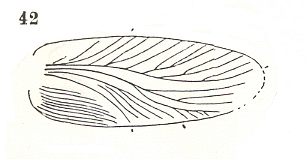
|
Poroblattina longula SCHLECHTENDAL
Family Poroblattinidae.
Length of tegmen 8 mm.
Locality : Wettin in Sachsen.
Stratum : Ottweiler Stufe, upper Upper-Carboniferous.
(After HANDLIRSCH, 1906, Taf.XXIX, fig.42, description p.286)
|
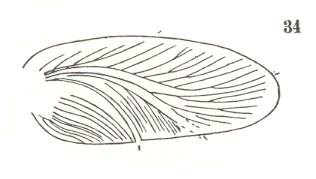
|
Poroblattina incerta SCHLECHTENDAL
Family Poroblattinidae.
Length of tegmen 8 mm.
Locality : Wettin in Sachsen.
Stratum : Ottweiler Stufe, upper Upper-Carboniferous.
(After HANDLIRSCH, 1906, Taf.XXIX, fig.34, description p.285)
|
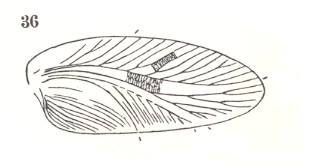
|
Poroblattina subtilis SCHLECHTENDAL
Family Poroblattinidae.
Length of tegmen 9 mm.
Locality : Wettin in Sachsen.
Stratum : Ottweiler Stufe,
upper Upper-Carboniferous.
(After HANDLIRSCH, 1906, Taf.XXIX, fig.36, description p.285)
|
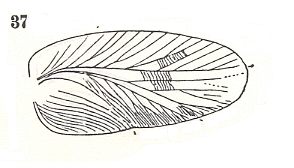
|
Poroblattina undosa SCHLECHTENDAL
Family Poroblattinidae.
Length of tegmen 8 mm.
Locality : Löbejün in Sachsen.
Stratum : Ottweiler Stufe,
upper Upper-Carboniferous.
(After HANDLIRSCH, 1906, Taf.XXIX, fig.37, description p.285)
|
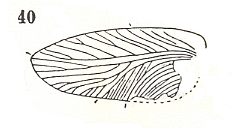
|
Poroblattina varia SCHLECHTENDAL
Family Poroblattinidae.
Length of tegmen 7 mm.
Locality : Wettin in Sachsen.
Stratum : Ottweiler Stufe,
upper Upper-Carboniferous.
(After HANDLIRSCH, 1906, Taf.XXIX, fig.40, description p.286)
|
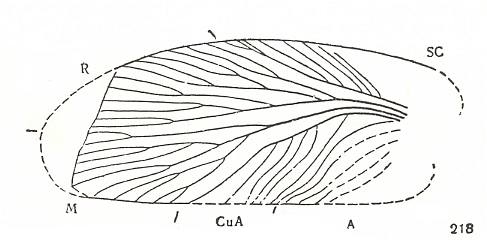
|
Ishanoblattina (Drepanoblattina) fodinensis BECKER-MIGDISOVA
Family Poroblattinidae.
Length of impression 22 mm. Total length of tegmen about 24-25 mm.
Porivaisky mine. Basin of Kuznets. Upper Carboniferous.
(After ROHDENDORF et al., 1961)
|
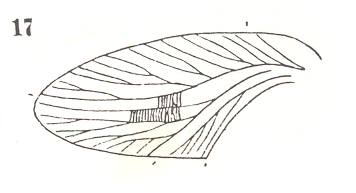
|
Nearoblatta exarata SCHLECHTENDAL
Family Poroblattinidae.
Length of tegmen about 8.5 mm.
Locality : Löbejün in Sachsen.
Stratum : Ottweiler Stufe,
upper Upper-Carboniferous.
(After HANDLIRSCH, 1906, Taf.XXX, fig.17, description p.292)
|
Mylacridid subtype :
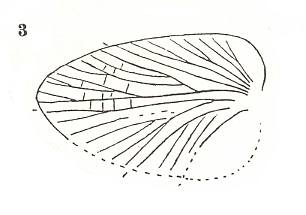
|
Pseudomylacris wettinensis SCHLECHTENDAL
Family Mylacridae.
Length of tegmen 7 mm.
Locality : Wettin in Sachsen.
Stratum : Ottweiler Stufe, upper Upper-Carboniferous.
(After HANDLIRSCH, 1906, Taf.XXIX, fig.3, description p.275)
|

|
Mylacridium superbum SCHLECHTENDAL
Family Mylacridae.
Length of tegmen about 8.5 mm.
Locality : Wettin in Sachsen.
Stratum : Ottweiler Stufe, upper Upper-Carboniferous.
(After HANDLIRSCH, 1906, Taf.XXIX, fig.13, description p.278)
|
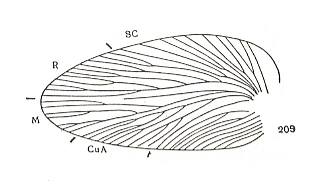
|
Mylacris anthracophila SCUDDER
Family Mylacridae.
Length of tegmen 33 mm.
Middle Upper-Carboniferous of North America.
(After SCUDDER, 1895, in Osnowy Paleontologii, ROHDENDORF et alii, 1962, Fig. 209.)
The size of this tegmen is unexpectedly large.
|
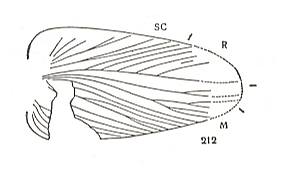
|
Pteridomylacris paradoxa HANDLIRSCH
Family Mylacridae.
Length of tegmen 17.5 mm.
Middle Upper-Carboniferous of North America.
(After HANDLIRSCH, 1906, in Osnowy Paleontologii, ROHDENDORF et alii, 1962, Fig. 212.)
|
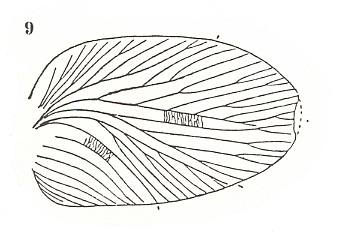
|
Cardioblatta Fritschi SCHLECHTENDAL
Family Mylacridae.
Length of tegmen about 16 mm.
Locality : Wettin in Sachsen.
Stratum : Ottweiler Stufe, upper Upper-Carboniferous.
(After HANDLIRSCH, 1906, Taf.XXIV, fig.9, description p.231)
|
Spiloblattinid subtype :
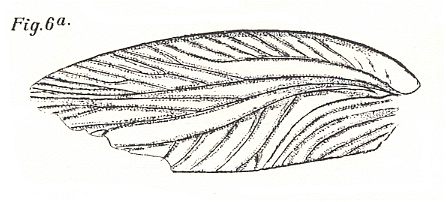
|
Sysciophlebia euglyptica GERMAR
Family Spiloblattinidae.
Length of fragment about 30 mm.
Wettin and Löbejü'n in Sachsen, Germany.
Ottweiler Stufe, upper Upper-Carboniferous.
(After SCHLECHTENDAL, 1912, Tab.V, fig.6a, see ibid. p.27-31)
|
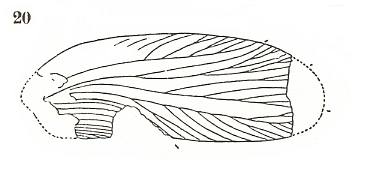
|
Sysciophlebia Cassvici SCUDDER
Family Spiloblattinidae.
Length of impression 26 mm.
Cassville, W. Va., USA. Dunkard formation, lower Permian.
(After SCUDDER, in HANDLIRSCH, 1906, Taf.XXXVI, fig.20, description, p.371)
|
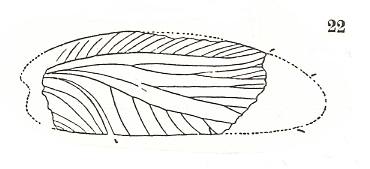
|
Sysciophlebia diversipennis SCUDDER
Family Spiloblattinidae.
Length of fragment 25 mm.
Cassville, W. Va., USA. Dunkard formation, lower Permian.
(After SCUDDER, in HANDLIRSCH, 1906, Taf.XXXVI, fig.22, description, p.371)
|
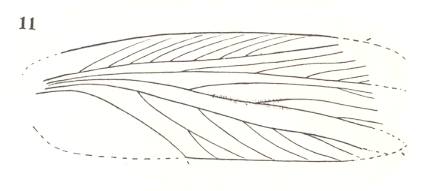
|
Sysciophlebia Martiusana SCHLECHTENDAL
Family Spiloblattinidae.
Length of fragment about 26 mm.
Locality : Gröbzig near Löbejün in Sachsen.
Stratum : Ottweiler Stufe,
upper Upper-Carboniferous.
(After HANDLIRSCH, 1906, Taf.XXV, fig.11, description p.241)
|
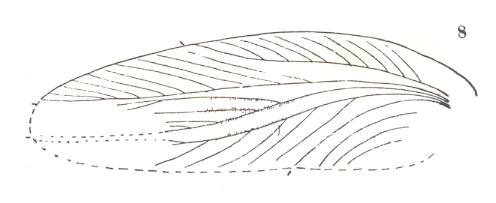
|
Sysciophlebia Huysseni SCHLECHTENDAL
Family Spiloblattinidae.
Length of tegmen about 31 mm.
Locality : Löbejün in Sachsen.
Stratum : Ottweiler Stufe,
upper Upper-Carboniferous.
(After HANDLIRSCH, 1906, Taf.XXV, fig.8, description p.241)
|
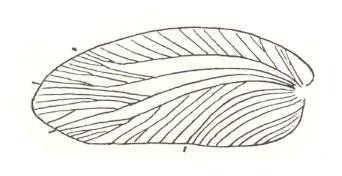
|
Sysciophlebia arcuata SELLARDS. Family Spiloblattinidae. Order Blattaria. Tegmen. Length 24 mm.
Upper Upper-Carboniferous of Kansas, USA.
(After SELLARDS, in HANDLIRSCH, 1906).
|
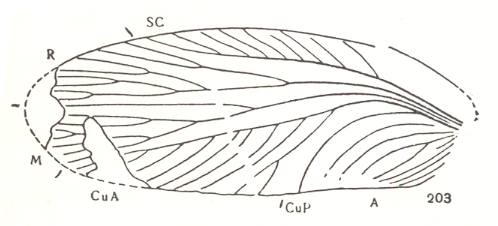
|
Sysciophlebia zavjalovensis BECKER-MIGDISOVA. Family Spiloblattinidae (or Archimylacridae, subfamily Spiloblattininae). Order Blattaria. Tegmen. Length 25.8 mm.
Middle Carboniferous of Kuznets Basin, Siberia, Russia.
(After BECKER-MIGDISOVA, 1961).
|
Noëtic construction (derivational lines and polydiagrams)
These, then, are examples of the five morphological venational subtypes of palaeozoic Blattida tegmina.
Now it is possible to set up at least three derivational lines (series) formally connecting, in at least three different ways, these venational subtypes, thanks to the existence of intermediates between them. These derivational lines, as they are detectable in the Explicate Order, are supposed to approximately reflect the noëtic construction, in the Implicate Order, of these venations -- as [the venation being] one particular aspect or part of the overall strategy-content construction. This reflection will eventually be expressed in polydiagrams.
Having examined the many known palaeozoic Blattida tegmina, including those presented above and in earlier documents (Saar-blattida, Wettin-blattida), but also many others still to come ( Dunkard-blattida, Kuznets-blattida, and others), we may set up three derivational lines formally connecting the above venational subtypes through existing intermediate forms :
- Archaic archimylacrid subtype ==> Phyloblatta subtype ==> Poroblattinid subtype ==> Mylacrid subtype.
- Archaic archimylacrid subtype ==> Phyloblatta subtype ==> (elongate) Spiloblattinid subtype.
- Archaic archimylacrid subtype ==> Phyloblatta subtype ==> (short) Spiloblattinid subtype.
In each such a "derivational line or series" the venations (and other features of the tegmen) are not in all cases strictly (in accordance with Dollo's law of irreversibility in evolution) derivable from one another. And, moreover, we cannot in all cases be completely sure of having assumed the correct direction of change (and thus of construction in the Implicate Order). Further, in our noëtic theory such a derivational line does not express probable evolutionary descent of one species from another, and thus not a descent of the corresponding venational characters. The connection between the members (i.e. between wing-venations) of such a derivational line is purely formal (and approximate). The derivational line only serves to provide some indications as to how the venation (or any other character-sequence making up such a line) of the "end-species" might have been constructed in the Implicate Order in the process of noëtic strategy formation.
Let us, then, begin with the first of these derivational lines :

|
Archimylacris lerichei PRUVOST.
Family Archimylacridae.
Length of tegmen 32.5 mm.
Upper Carboniferous of France.
(After PRUVOST, 1919, in TILLYARD, 1937)
Shoulder area of wing relatively broad.
Subcosta not pectinate.
Radius dichotomically branching.
CuA area moderately extensive.
|
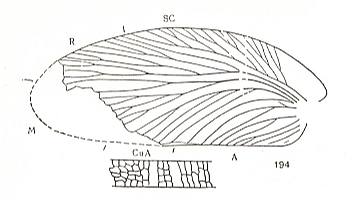
|
Archaeotiphites petroblattinoides BECKER-MIGDISOVA
Family Archimylacridae. Order Blattaria. Tegmen. Length 38 mm.
Middle Carboniferous of Kuznets Basin, Siberia, Russia.
(After BECKER-MIGDISOVA, 1961).
Subcosta longer, and subparallel to Costa.
CuA area contracted.
|
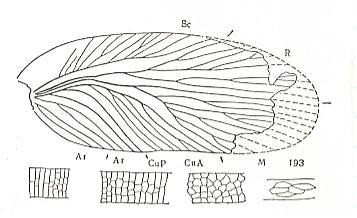
|
Grypoblattites flabellatus BECKER-MIGDISOVA
Family Archimylacridae. Order Blattaria. Tegmen. Length 22 mm.
Middle Carboniferous of Kuznets Basin, Siberia, Russia.
(After BECKER-MIGDISOVA, 1961).
Branches of CuA tending to descend steeper onto the wing's hind margin.
|

|
Ishanoblattina (Drepanoblattina) fodinensis BECKER-MIGDISOVA
Family Poroblattinidae.
Length of impression 22 mm. Total length of tegmen about 24-25 mm.
Porivaisky mijn. Basin of Kuznets. Upper Carboniferous.
(After ROHDENDORF et al., 1961)
Branches of CuA tending to descend still steeper onto the wing's hind margin.
|
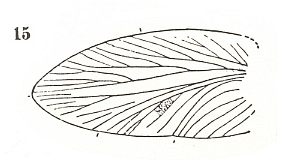
|
Sphaleroblattina ingens SCHLECHTENDAL
Family : Archimylacridae or Poroblattinidae.
Length of tegmen about 10 mm.
Locality : Wettin in Sachsen.
Stratum : Ottweiler Stufe,
upper Upper-Carboniferous.
(After HANDLIRSCH, 1906, Taf.XXIV, fig.15, description p.234)
As to the course of the branches of CuA, this form should have to be placed after Archaeotiphites petroblattinoides above, but, as to its small size it better connects with the next form (Poroblattina varia).
|

|
Poroblattina varia SCHLECHTENDAL
Family Poroblattinidae.
Length of tegmen 7 mm.
Locality : Wettin in Sachsen.
Stratum : Ottweiler Stufe,
upper Upper-Carboniferous.
(After HANDLIRSCH, 1906, Taf.XXIX, fig.40, description p.286)
Subcostal area contracted.
CuA area still further contracted. Branches of CuA descend onto the wing's hind margin at almost right angles.
|

|
Mylacridium superbum SCHLECHTENDAL
Family Mylacridae.
Length of tegmen about 8.5 mm.
Locality : Wettin in Sachsen.
Stratum : Ottweiler Stufe, upper Upper-Carboniferous.
(After HANDLIRSCH, 1906, Taf.XXIX, fig.13, description p.278)
Broad shoulder of wing.
Point of attachment of tegmen to thorax has shifted toward the median line of the wing.
CuA branches reduced in number. CuA area still narrow.
|
Especially when we inspect the Mylacrid subtype we can see that there must have been more than one such a series, each one of them starting off from some archaic archimylacrid and ending up with a slightly different mylacrid. And indeed, these series could each have started off from a different archaic archimylacrid.
Based on this first derivational line, we now set up a polydiagram that expresses the noëtic construction of each venational structure (apart from the first) of this line :
And to repeat again : In order to fully appreciate the exposition of the noëtic construction of blattida tegmina with the help of so-called polydiagrams, the reader may consult the two-document " Theoretic Intermezzo" which is inserted into the present series of documents after part VIII (Heteropterygia). For "polydiagrams" in particular the reader should, in that same " Theoretic Intermezzo", consult the Section Polyphyletic development of strategy-contents and their noëtic construction in the Implicate Order (to be found at about the last sixth of the (first) document).
A. lerichei A. petroblattinoides G. flabellatus I. fodinensis S. ingens P. varia M. superbum
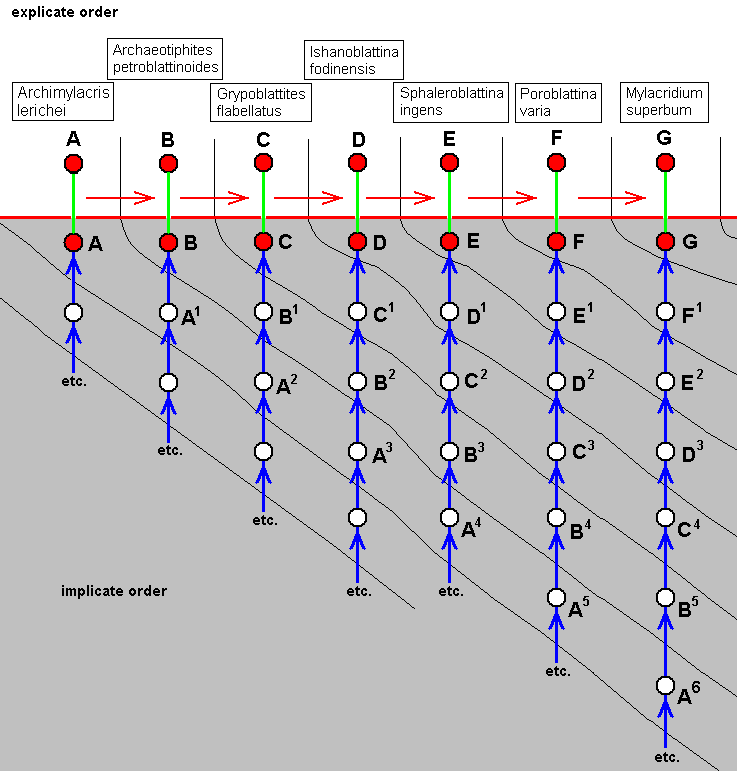
Polydiagram based on first derivational line. The diagram suggests that :
- The noëtic construction line -- . . . A6 ==> B5 ==> C4 ==> D3 ==> E2 ==> F1 ==> G -- of the venation of Mylacridium superbum is rougly reflected by the the series of existing venations of, respectively, the species :
Archimylacris lerichei ==> Archaeotiphites petroblattinoides ==> Grypoblattites flabellatus ==> Ishanoblattina fodinensis ==> Sphaleroblattina ingens ==> Poroblattina varia ==> Mylacridium superbum.
- The noëtic construction line -- . . . A5 ==> B4 ==> C3 ==> D2 ==> E1 ==> F -- of the venation of Poroblattina varia is rougly reflected by the the series of existing venations of, respectively, the species :
Archimylacris lerichei ==> Archaeotiphites petroblattinoides ==> Grypoblattites flabellatus ==> Ishanoblattina fodinensis ==> Sphaleroblattina ingens ==> Poroblattina varia.
- The noëtic construction line -- . . . A4 ==> B3 ==> C2 ==> D1 ==> E -- of the venation of Sphaleroblattina ingens is rougly reflected by the the series of existing venations of, respectively, the species :
Archimylacris lerichei ==> Archaeotiphites petroblattinoides ==> Grypoblattites flabellatus ==> Ishanoblattina fodinensis ==> Sphaleroblattina ingens.
- The noëtic construction line -- . . . A3 ==> B2 ==> C1 ==> D -- of the venation of Ishanoblattina fodinensis is rougly reflected by the the series of existing venations of, respectively, the species :
Archimylacris lerichei ==> Archaeotiphites petroblattinoides ==> Grypoblattites flabellatus ==> Ishanoblattina fodinensis.
- The noëtic construction line -- . . . A2 ==> B1 ==> C -- of the venation of Grypoblattites flabellatus is rougly reflected by the the series of existing venations of, respectively, the species :
Archimylacris lerichei ==> Archaeotiphites petroblattinoides ==> Grypoblattites flabellatus.
- The noëtic construction line -- . . . A1 ==> B -- of the venation of Archaeotiphites petroblattinoides is rougly reflected by the the series of existing venations of, respectively, the species :
Archimylacris lerichei ==> Archaeotiphites petroblattinoides.
As has been said, the real (as opposed to supposed or suggested) noëtic constructions of the venations in the Implicate Order are only roughly reflected by the sequence of materially existing venations making up the derivational line. And even that these noëtic constructions are so reflected is just a hypothesis.
The above polydiagram at least offers us an idea of how the venations might be formed in the Implicate Order, and how they are formally related to one another.
We now set up the next possible, i.e. the second, derivational line :
|

|
Etoblattina primaeva GOLDENBERG
Family Archimylacridae. Order Blattaria. Tegmen. Length of preserved part 27.0 mm. Total length about 33.0 mm.
Middle Upper-Carboniferous of Saar Region, Germany.
(After GUTHÖRL, 1934).
Shoulder of wing relatively broad.
Subcosta not pectinate, and not subparallel to Costa.
Point of attachment of tegmen to thorax seems to be shifted towards middle of wing base like in Mylacridae. But the large size of the tegmen seems to forbid it to belong to the latter family.
|

|
Phyloblatta plana SCHLECHTENDAL
Family Archimylacridae.
Length of tegmen about 26 mm.
Locality : Wettin in Sachsen.
Stratum : Ottweiler Stufe,
upper Upper-Carboniferous.
(After HANDLIRSCH, 1906, Taf.XXII, fig.16, description p.213)
Tegmen somewhat more elongate.
Subcosta subparallel to Costa.
|
|

|
Permoblattina curta SELLARDS. Family Spiloblattinidae.
Lower Permian of Kansas, USA. Length 15 mm. Specimen No 15663 (After TILLYARD, 1937)
Subcosta has become definitely pectinate.
Medio-Cubital vein-free area extending all the way to the wing margin.
|
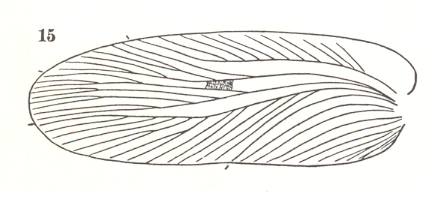
|
Phyloblatta wittekindiana SCHLECHTENDAL
Family Archimylacridae.
Length of tegmen about 27 mm.
Locality : Bad Wittekind near Halle.
Stratum : Ottweiler Stufe,
upper Upper-Carboniferous.
(After HANDLIRSCH, 1906, Taf.XXII, fig.15, description p.212)
Subcosto-Radial, Radio-Medial, and Medio-Cubital vein-free areas broadened.
Medio-Cubital vein-free area not extending (in its full width) to wing margin. In this respect the form resembles Phyloblatta plana a little above.
|

|
Sysciophlebia diversipennis SCUDDER
Family Spiloblattinidae.
Length of fragment 25 mm.
Cassville, W. Va., USA. Dunkard formation, lower Permian.
(After SCUDDER, in HANDLIRSCH, 1906, Taf.XXXVI, fig.22, description, p.371)
Impoverishment (reduction) of venation (except the Subcostal system).
|

|
Sysciophlebia euglyptica GERMAR
Family Spiloblattinidae.
Length of fragment about 30 mm.
Wettin and Löbejün in Sachsen, Germany.
Ottweiler Stufe, upper Upper-Carboniferous.
(After SCHLECHTENDAL, 1912, Tab.V, fig.6a, see ibid. p.27-31)
In the drawing of this form the weakening of the archedictyon is explicitly indicated (as in the next form).
|
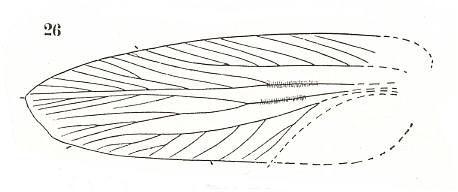
|
Dicladoblatta subtilis SCHLECHTENDAL
Family Spiloblattinidae.
Length of fragment about 24 mm.
Locality : Wettin in Sachsen.
Stratum : Ottweiler Stufe,
upper Upper-Carboniferous.
Two specimens.
(After HANDLIRSCH, 1906, Taf.XXVI, fig.26 and 27, description p.252)
Fore and hind margins of tegmen subparallel.
|
When we look to the known Spiloblattinidae (as in the above given examples of the Spiloblattinid subtype as well as the (other) ones presented in the faunistic document about the Blattida of Wettin ), we realize that there can be found more than one derivational lines, each starting off from some representative of the Archaic archimylacrid subtype and each ending up into a different spiloblattinid.
Based on this second derivational line, we now set up a polydiagram that expresses the noëtic construction of each venational structure (apart from the first) of this line :
E. primaeva Ph. plana P. curta Ph. wittekindiana S. diversipennis S. euglyptica D. subtilis
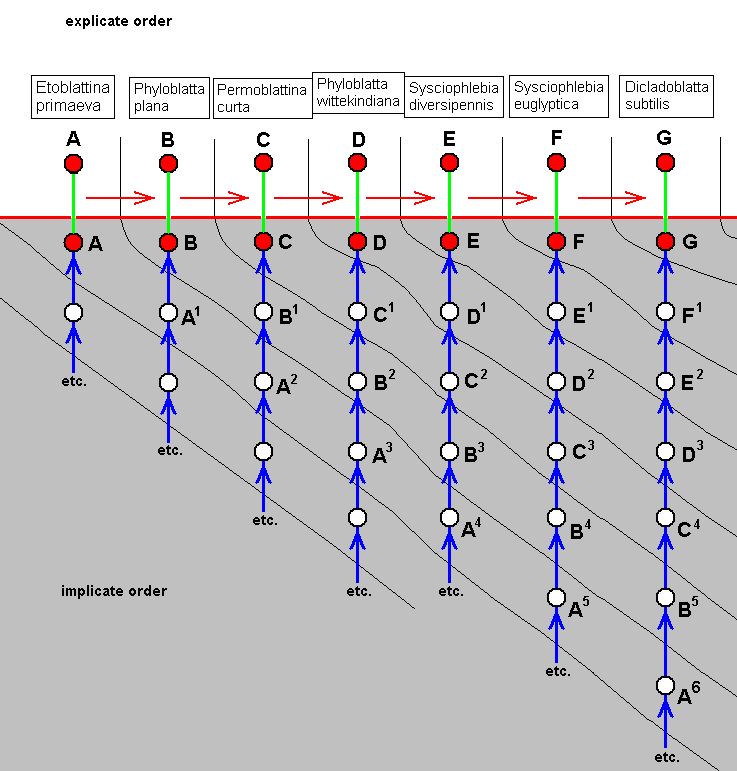
Polydiagram based on second derivational line. The diagram suggests that :
- The noëtic construction line -- . . . A6 ==> B5 ==> C4 ==> D3 ==> E2 ==> F1 ==> G -- of the venation of Dicladoblatta subtilis is rougly reflected by the the series of existing venations of, respectively, the species :
Etoblattina primaeva ==> Phyloblatta plana ==> Permoblattina curta ==> Phyloblatta wittekindiana ==> Sysciophlebia diversipennis ==> Sysciophlebia euglyptica ==> Dicladoblatta subtilis.
- The noëtic construction line -- . . . A5 ==> B4 ==> C3 ==> D2 ==> E1 ==> F -- of the venation of Sysciophlebia euglyptica is rougly reflected by the the series of existing venations of, respectively, the species :
Etoblattina primaeva ==> Phyloblatta plana ==> Permoblattina curta ==> Phyloblatta wittekindiana ==> Sysciophlebia diversipennis ==> Sysciophlebia euglyptica.
- The noëtic construction line -- . . . A4 ==> B3 ==> C2 ==> D1 ==> E -- of the venation of Sysciophlebia diversipennis is rougly reflected by the the series of existing venations of, respectively, the species :
Etoblattina primaeva ==> Phyloblatta plana ==> Permoblattina curta ==> Phyloblatta wittekindiana ==> Sysciophlebia diversipennis.
- The noëtic construction line -- . . . A3 ==> B2 ==> C1 ==> D -- of the venation of Phyloblatta wittekindiana is rougly reflected by the the series of existing venations of, respectively, the species :
Etoblattina primaeva ==> Phyloblatta plana ==> Permoblattina curta ==> Phyloblatta wittekindiana.
- The noëtic construction line -- . . . A2 ==> B1 ==> C -- of the venation of Permoblattina curta is rougly reflected by the the series of existing venations of, respectively, the species :
Etoblattina primaeva ==> Phyloblatta plana ==> Permoblattina curta.
- The noëtic construction line -- . . . A1 ==> B -- of the venation of Phyloblatta plana is rougly reflected by the the series of existing venations of, respectively, the species :
Etoblattina primaeva ==> Phyloblatta plana.
And, as has been said, the real (as opposed to supposed or suggested) noëtic constructions of the venations in the Implicate Order are only roughly reflected by the sequence of materially existing venations making up the derivational line. And even that these noëtic constructions are so reflected is just a hypothesis.
The above polydiagram at least offers us an idea of how the venations might be formed in the Implicate Order, and how they are formally related to one another.
Finally, we set up the third derivational line formally connecting palaeozoic blattaria tegmina :
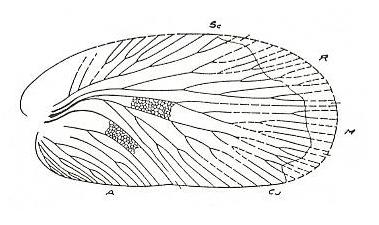
|
Platyblatta propria KLIVER
Family Archimylacridae.
Length of complete wing about 34 mm.
Location : Mine (Grube) Frankenholz-Saar.
Stratum : Westphalian D, upper Saarbrücker Schichten, Liegende [= lower part of] Flammkohlenpartie.
After GUTHÖRL, 1936
|
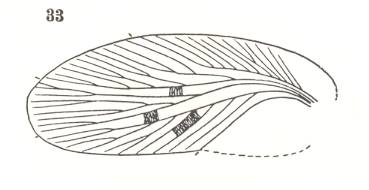
|
Phyloblatta perfecta SCHLECHTENDAL
Family Archimylacridae.
Length of tegmen about 21 mm.
Locality : Wettin in Sachsen.
Stratum : Ottweiler Stufe,
upper Upper-Carboniferous.
(After HANDLIRSCH, 1906, Taf.XXII, fig.33, description p.217)
|
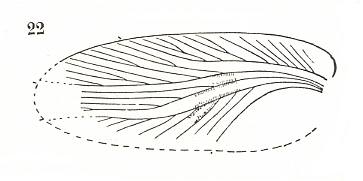
|
Sysciophlebia tenera SCHLECHTENDAL
Family Spiloblattinidae.
Length of tegmen about 21 mm.
Locality : Wettin in Sachsen.
Stratum : Ottweiler Stufe,
upper Upper-Carboniferous.
(After HANDLIRSCH, 1906, Taf.XXV, fig.22, description p.243)
Here the archedictyon is weakened centrally between the veins, in contrast to the previous form.
|
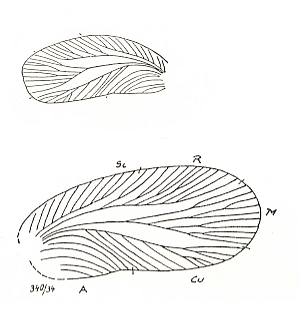
|
Sysciophlebia pygmaea MEUNIER
Family Spiloblattinidae.
Length, 18 mm.
Location : Mine (Grube) Ensdorf-Saar. Ensdorf shaft at Griesborn, 9. subterranean floor (Tiefbausohle).
Stratum : Stephanian [A {JB}], lower Ottweiler Schichten. Roof of the Schwalbacher (= Lummerschieder) Flöz.
Upper image : after MEUNIER, in HANDLIRSCH, 1906, p.245, and Taf XXV, fig. 34.
Lower image : after GUTHÖRL, 1934, p.151, Abb. 97.
Radio-Medial free space and Medial-Cubital free space have become significantly broader, especially in their middle portions.
Tegmen remains short.
|

|
Sysciophlebia arcuata SELLARDS. Family Spiloblattinidae. Order Blattaria. Tegmen. Length 24 mm.
Upper Upper-Carboniferous of Kansas, USA.
(After SELLARDS, in HANDLIRSCH, 1906).
Typical Spiloblattinid venation, but the tegmen untypically short.
Subcosta long and pectinate.
|
Based on this third derivational line, we now set up a polydiagram that expresses the noëtic construction of each venational structure (apart from the first) of this line :
P. propria Ph. perfecta S. tenera S. pygmaea S. arcuata
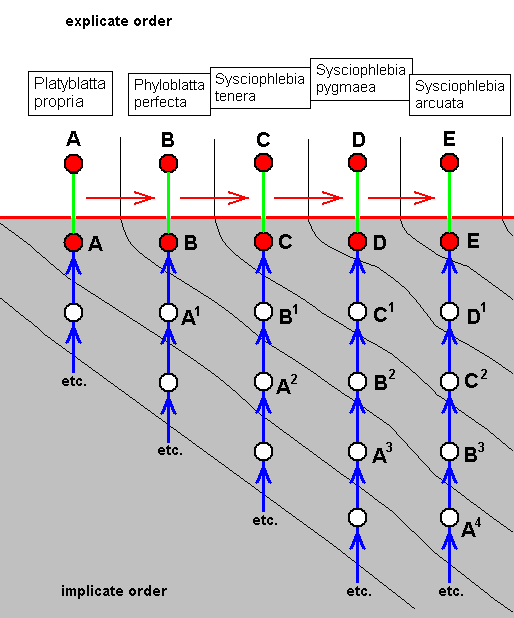
Polydiagram based on third derivational line. The diagram suggests that :
And again we must note that the real (as opposed to supposed or suggested) noëtic constructions of the venations in the Implicate Order are only roughly reflected by the sequence of materially existing venations making up the derivational line. And even that these noëtic constructions are so reflected is just a hypothesis.
The above polydiagram at least offers us an idea of how the venations might be formed in the Implicate Order, and how they are formally related to one another.
The fossil Blattida species of the above three derivational lines are geologically and geographically distributed as follows :
First derivational line (geologic and geographic sites mentioned only once) :
Carboniferous of France.
Carboniferous of Kuznets basin, Siberia, Russia.
Carboniferous of Wettiner region, near Halle, Germany.
Second derivational line (geologic and geographic sites mentioned only once) :
Carboniferous of Saar region, Germany.
Carboniferous of Wettiner region, near Halle, Germany.
Lower Permian of Kansas, USA.
Lower Permian of Dunkard basin, W.Va., USA.
Third derivational line (geologic and geographic sites mentioned only once) :
Carboniferous of Saar region, Germany.
Carboniferous of Wettiner region, near Halle, Germany.
Carboniferous of Kansas, USA.
As one can see, the method of determining the noëtic construction of venational patterns (and, if supplemented with other characters, of whole strategies) in accordance with our "noëtic theory of evolution", does not know of any constraints as to the locations and time-horizons of the species concerned. Indeed, our theory only lays stress on the correlation of species and ecological existential condition, regardless of geographical location or geologic time. This is, because our theory does not suppose that species do evolve from one another, and doesn't need to suppose long-distance migrations to explain the existence of similar forms in widely separated geographical regions.
In all the above we have shown how one should proceed to make schemes expressing the noëtic and polyphyletic development of insect wing-venation. And as has been explained in Theoretic Intermezzo (inserted after part VIII of the present series of documents), the wing-venation is just a mere part of the strategy sensu lato of the species under investigation. In order to show the noëtic construction -- in the Implicate Order -- of the complete strategy, we must set up -- as to insects belonging to the group in which the venation was studied, and, if necessary, to species outside that group but nevertheless related to its members -- a derivational line (series) for each (morphological) character in turn. An as we did with wing-venation, we try to set up a series connecting the states of such a character as to its increasing apomorphy. We surely expect that the resulting derivational lines set up for different characters will not be 'synchronous' with each other. But beause we do not look for species or whole strategies allegedly having descended from each other, this 'synchronicity' is not necessary at all for our investigation, as long as we take as the end-point of every derivational line (each one handling one character) the same species (strategy). In this way we will get (if sufficient data are available) a bundle of derivational lines together more or less reflecting the noëtic construction of a whole strategy.
In practise we don't have at our disposal data of all these different characters and their various states. But in the case of winged insects we could perhaps confine ourselves to only their wing-venation, because the latter is virtually the only character that is well-preserved in fossil insects. And, although we can, in trying to determine noëtic construction, limit ourselves to recent organisms, the results may be much more significant when fossils are included.
With this we conclude the exposition of the noëtic construction, in the Implicate Order, of the various palaeozoic Blattida tegmina with the help of fossil forms. In the next document we will describe the blattarian fauna of the Lower Permian of the Dunkard Basin, S.E. United States.
e-mail :  ( Please write in ' Subject ' entry : ' METAPHYSICS ', in order for me to be able to distinguish your mail from spam )
( Please write in ' Subject ' entry : ' METAPHYSICS ', in order for me to be able to distinguish your mail from spam )
To continue click HERE for the next Blattarian faunistic complex of the lower Permian of the Dunkard Basin, USA. Part IIIc
Back to Homepage
Back to Contents
Fifth Part of Website
Back to Part I
Back to Part II
Back to Part III
Back to Part IIIa
Back to Part IIIaa
Back to Part IIIb


 ( Please write in ' Subject ' entry : ' METAPHYSICS ', in order for me to be able to distinguish your mail from spam )
( Please write in ' Subject ' entry : ' METAPHYSICS ', in order for me to be able to distinguish your mail from spam )







 ( Please write in ' Subject ' entry : ' METAPHYSICS ', in order for me to be able to distinguish your mail from spam )
( Please write in ' Subject ' entry : ' METAPHYSICS ', in order for me to be able to distinguish your mail from spam )